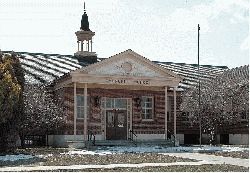Churchill School added to historic buildings list
Published 12:00 am Wednesday, March 26, 2008

- Churchill School has been named to the National Register of Historic Places. (Baker City Herald/Kathy Orr).
By MIKE FERGUSON
Trending
Baker City Herald
Tourists who marvel at the architecture and the splendor of the Geiser Grand Hotel and the Baker Tower will have one more historically significant building to visit on their next trip to Baker City.
Churchill School has been named to the National Register of Historic Places, the 12th such Baker County building to make the list along with Baker City’s entire historic downtown district.
Trending
andquot;We are very pleased with the enthusiasm of the (State) Historic Preservation Office for listing this lovely building,andquot; said Pamela Van Duyn, who with her husband Jim purchased Churchill from the Baker 5J District in December 2006 for $205,000.
The school was constructed in a little over three months in late 1925 and early 1926 at a cost of $45,000. It was named for J.A. Churchill, an early superintendent of the Baker City schools, founder of the local YMCA and later state superintendent of public instruction and the first president of what is now Southern Oregon University.
Jim Van Duyn, himself an architect, said the building, at 3451 Broadway, is notable because it’s the work of a master architect, Charles B. Miller. On top of that, it’s an andquot;outstandingandquot; example of Georgian Revival architecture. Churchill is the only school Miller designed.
andquot;It’s a handsome little building, especially viewed in the context of his other work,andquot; Jim Van Duyn said. Miller also designed La Grande’s Roesch Building (commonly called the Sac Annex) and La Grande’s First Presbyterian Church.
andquot;(Churchill) demonstrates a portion of his skill, and not much of his work remains, unfortunately,andquot; Jim Van Duyn said.
The 1931 Sac Annex is already on the National Register as is a Miller-designed home, the 1924 A.J. Stange House in La Grande.
In October, the Van Duyns presented their nomination to a SHPO advisory board and won unanimous approval. The National Park Service has final say over Register nominations; that agency delivered the Van Duyns their good news about four days ago.
andquot;It is a long process, and we are delighted,andquot; Jim Van Duyn said. Gaining a place on the Register was andquot;far from a sure thing,andquot; he said, because the Park Service is more particular about the buildings it allows on the list.
andquot;In the early to mid-1970s, people were alarmed over the disappearance of fine old buildings,andquot; Van Duyn said. andquot;There was such an interest on those preservation committees that they didn’t have to be real rigorous with the nominations.
andquot;But that has changed. Now it’s harder to qualify, because the criteria are different.andquot;
It helped, he said, that Churchill represents andquot;the work of a master.andquot;
Making the list will help the owners develop the property. According to the Web site oregonheritage.org, owners of property named to the Register are entitled to a federal tax credit that can save 20 percent of rehabilitation costs. Owners can also receive a 15-year freeze on the assessed value of their property. They’re also eligible for building code leniency and can apply for competitive Preserving Oregon historic rehabilitation grants.
Inclusion on the Register means the Van Duyns can begin rehabilitating their property. For now the couple’s plan is to turn it into between 14 and 18 one- and two-bedroom apartments for people 55 and older, Jim Van Duyn said.
andquot;One reason we haven’t taken a lot of action until now is if you make improvements before you receive the designation, it’s not eligible for tax breaks,andquot; he said. andquot;It behooved us to wait until that was determined.andquot;
The couple envision people downsizing once their children have grown and left home, the sort of andquot;lock and goandquot; facility that St. Elizabeth Towers pioneered here.
andquot;When we purchased the building, we ran a few economic models on what worked financially,andquot; he said. andquot;They will be very nice residences, with some outdoor space. We think there are people in the community whose children have left who will think, ‘This is too much house for me.’ They want to travel, and they want to go knowing their home is in a protected and secure environment. That appeals to a lot of people.andquot;
Alterations to the original building are mostly superficial, the Van Duyns said in a press release. The triple-hung paned windows are all in place but are partially blocked by insulation. Removing the insulation will andquot;floodandquot; Churchill with natural light, they said.
The school features hardwood floors throughout the structure and a cupola capping the roof, a distinguishing feature of the Georgian Revival style.
The work will require not only approval from city officials, but the blessing of the State Historic Preservation Office, which administers the Register program for the National Park Service.
andquot;We’ll need to develop what our intentions are, then sit down with SHPO technicians to make sure we’re conforming with their guidelines,andquot; Jim Van Duyn said. andquot;We’re going to save those old window sashes, because we really want to preserve the character of the building.
andquot;When you have questions like, ‘What kind of roof can we put on,’ you really want to stay within their guidelines.andquot;









